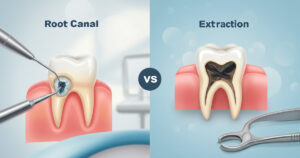Root canal treatment is one of the most common procedures in modern dentistry, and has a very high success rate. However, patients sometimes experience side effects and complications. These can range from short-term discomfort, like pain and swelling, to rare but serious risks, such as nerve damage or sinus issues.
Informed patients recover faster and feel more confident about their root canal therapy. That’s why this guide covers the most important root canal treatment side effects, risks, and preventive steps, as well as alternatives you may want to discuss with your dentist. Let’s start with the short-term discomforts.
Root Canal Treatment Side Effects: Short-Term Symptoms
After the anesthesia wears off, it’s normal to experience some discomfort. Pain, swelling, and mild sensitivity usually appear within the first 24-48 hours. For most patients, sensitive teeth and this mild pain are manageable with over-the-counter pain relievers like ibuprofen.
You may also notice sensitivity when chewing or biting, especially if the treated tooth was badly infected before. This discomfort usually improves within a few days as the tissue heals.

A useful way to understand recovery is to compare the expected vs. concerning symptoms:
| Symptom | Normal (Temporary) | When to Call Your Dentist |
| Mild pain or soreness | Lasts 2–3 days | Severe pain beyond 5 days |
| Swelling | Slight gum swelling | Rapid or severe swelling |
| Sensitivity to hot/cold | Improves with time | Worsens or persists for weeks |
| Mild bleeding | Stops quickly | Prolonged or heavy bleeding |
Quick Tip: Keep a record of your symptoms. If pain gets worse after day three or swelling spreads, call your dentist. These can be signs of a developing phoenix abscess or root canal reinfection.
Long-Term Side Effects of Root Canal Therapy
Side effects are possible with any medical or dental procedure. In root canal therapy, most symptoms are temporary and manageable, as mentioned earlier. But some, like tooth discoloration, brittle teeth, or re-infection, may appear later if the tooth is not restored properly.
1. Tooth Discoloration
After a root canal, a tooth may lose its natural color and appear darker or grayish. This happens because the blood supply and living tissue (pulp) have been removed. Over time, pigments from blood breakdown or filling materials can seep into the dentin.
While this discoloration doesn’t affect function, it may affect your confidence when you smile. Cosmetic treatments such as internal bleaching or covering the tooth with a crown or veneer can restore a natural appearance.
2. Brittle Tooth
Teeth that have undergone root canal therapy are more fragile than healthy teeth because they lack moisture and blood supply from the pulp. This makes them prone to cracking or breaking under chewing pressure, especially if they’re back molars that handle heavy bite forces.
Without a protective crown, the risk of fracture is significantly higher. Once a tooth fractures below the gumline, it may no longer be restorable and require extraction.
3. Reinfection of the Tooth
Root canals have tiny, complex pathways. If a canal is missed, improperly sealed, or if the crown or filling develops a leak, bacteria can re-enter and cause reinfection. Symptoms include swelling, pain, or gum abscesses.
In such cases, retreatment or an apicoectomy (removal of the root tip) may be required. Reinfection is one of the leading causes of root canal failure, but it is preventable with precise treatment and follow-ups.
4. Chronic Pain or Lingering Sensitivity
While most patients heal fully, some may continue to feel discomfort for months. This could be due to nerve irritation, tiny accessory canals harboring bacteria, or bite misalignment, placing stress on the treated tooth. Chronic nerve-related pain can be frustrating, but should not be ignored; dentists can identify the underlying cause and recommend retreatment or bite adjustments.

5. Abscess Formation
A dental abscess is a pocket of pus that develops at the root tip if infection lingers. This can cause swelling in the gum, jaw, or even face. In some cases, patients notice a small pimple-like bump on the gum that drains pus (fistula). Abscesses not only cause pain but also risk spreading to nearby tissues or, rarely, into the bloodstream. Treatment may involve antibiotics, retreatment, or surgical procedures.
6. Gum Inflammation Around the Root Canal Tooth
Sometimes, the gums around a treated tooth remain swollen or red. This may result from a poorly sealed crown margin, reinfection, or irritation from bacteria in the gum pockets. Chronic gum inflammation makes it harder to maintain oral hygiene and can lead to bone loss if untreated.
7. Tooth Fracture
Because root canal teeth are weakened, they can fracture more easily than vital teeth. Cracks can run vertically down the root, which may not be repairable and could lead to tooth loss. Preventing this complication is why dentists almost always recommend full-coverage crowns for back teeth after a root canal.
8. Jaw Soreness or Stiffness
Some patients develop soreness in the jaw joint (TMJ) or surrounding muscles after root canal therapy. This is usually due to keeping the mouth open for an extended period during treatment, but in rare cases, infection spreading into the jawbone can also cause stiffness or aching. Typically, soreness subsides with rest, warm compresses, or anti-inflammatory medication.
Root Canal Serious Complications
Although uncommon, serious risks and complications can occur and are important to understand. Let’s explore these rare but serious complications.
Phoenix Abscess & Persistent Infection
A phoenix abscess is a flare-up of infection that develops shortly after treatment, usually due to remaining bacteria or poor sealing of the canal. It causes swelling, severe pain, and sometimes fever. Persistent infections can also occur if hidden canals are missed.
Allergic Reactions
Although rare, allergic reactions can occur during or after a root canal. This usually happens if a patient is sensitive to certain dental materials, such as latex, local anesthetics, or the filling and sealing compounds used inside the tooth.
Sinus Issues
The roots of upper back teeth (molars and premolars) are located very close to the maxillary sinuses. During a root canal, if instruments or filling material extend slightly beyond the root tip, they can irritate the sinus lining. This can lead to symptoms such as nasal congestion, sinus pressure, mild headache, or post-nasal drip.
In rare cases, a small sinus perforation can occur, which usually heals on its own but may sometimes require additional treatment. Most sinus-related issues after root canal treatment are temporary and resolve with proper care and medication.
Nerve Damage
Nerve damage during a root canal is extremely uncommon, but it can happen if instruments or filling material go beyond the root tip and affect surrounding nerves. This is more likely in lower molars, where the roots sit near the mandibular nerve. In many cases, this irritation improves over time as the nerve heals. However, if the damage is significant, it may lead to prolonged or permanent numbness. Dentists use precise imaging and careful techniques to minimize this risk.

How to Prevent Root Canal Side Effects
Prevention is often the best medicine. Taking the right steps after your root canal can reduce complications.
Proper Restoration
The most important step after a root canal is protecting the tooth. Placing a crown or durable filling shortly after treatment is essential to restore strength and function. Skipping this step leaves the tooth vulnerable to breakage and reinfection.
Good Oral Hygiene & Follow-Ups
- Brush twice daily with fluoride toothpaste.
- Floss carefully to prevent new decay around the treated tooth.
- Rinse with antibacterial mouthwash to keep bacteria levels low.
- Schedule regular follow-ups, so your dentist can monitor healing and ensure the crown or filling remains sealed.
Contact Us for Help!
If you’re experiencing root canal chronic pain or complications after a root canal, don’t wait. Book an appointment with Smile Avenue Dentistry today! Our team is here to protect your smile and ensure your recovery goes smoothly.
Alternatives to Root Canal Treatment
While root canals are usually the best option to save a tooth, they’re not the only solution.
- Pulp Capping: If decay hasn’t reached deep into the pulp, the dentist may place a protective material to help the pulp heal naturally.
- Pulpotomy: Commonly used in children, this involves removing only the infected part of the pulp while keeping the rest intact.
- Apicoectomy: A surgical procedure to remove the tip of the root and infected tissue.
- Extraction: When a tooth cannot be saved, removing it may be the best choice. The gap can be replaced with an implant or bridge.
- Retreatment: If a root canal fails, repeating the procedure can often save the tooth without surgery.
Conclusion
An endodontic treatment is safe, effective, and often the only way to save a severely damaged tooth. While root canal treatment side effects and complications are possible, most are temporary and manageable. With proper care, restorations, and follow-up, you can protect your treated tooth for many years.
At Smile Avenue Dentistry, our mission is to make your treatment safe, comfortable, and long-lasting. If you’re worried about root canal side effects, our endodontist in North York will guide you throughout the entire process, ensuring you’ll experience no side effects.
FAQ
-
What are the common side effects after a root canal?
Mild pain, swelling, and sensitivity are the most common short-term effects. They usually fade within a few days.
-
What is a phoenix abscess and how serious is it?
It’s a type of infection flare-up after treatment. It may occur after a root canal treatment and can be painful, requiring urgent dental care, but it is treatable.
-
How can I minimize my risks after a root canal?
Choose a professional dentist or endodontist, have the tooth restored with a crown or filling, maintain excellent oral hygiene, pay attention to your diet after the procedure, and attend follow-up visits.
-
Are there alternatives to root canals?
Yes. Options include pulp capping, pulpotomy, apicoectomy, extraction, and retreatment, depending on your case.
Have you ever experienced side effects after a root canal treatment? Share what you went through in the comments; we’d love to hear how you managed recovery!




